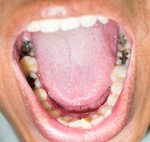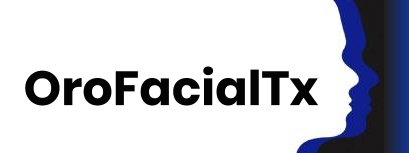What is a Myofunctional Disorder?
Orofacial Myofunctional Disorders (OMDs) are disorders of the muscles and functions of the face and mouth. OMDs may affect, directly and/or indirectly, breastfeeding, facial skeletal growth and development, chewing, swallowing, speech, occlusion, temporomandibular joint movement, oral hygiene, stability of orthodontic treatment, and more.
Most OMDs begin with oral versus nasal breathing. The mouth opens, the tongue drops low in the mouth, and the orofacial structure collapses over time creating a narrowing of the roof of the mouth and dental arches, crowded teeth, difficulty chewing/swallowing, and sleep disordered breathing.
How did this Orofacial Myofunctional Disorder begin?
It happened over time as a result of your body adapting to a habit. If you were born with a tongue tie for instance, a restriction was present that pulled your tongue towards the floor of your mouth versus the roof of your mouth. That limitation of movement prevented your tongue from applying pressure against your hard palate and your dental arches began to collapse. If we catch tongue ties sooner rather than later, a child’s growth and development is positively impacted. If the tongue tie goes unnoticed, changes in the way a person chews, speaks, swallows, breathes, and sleeps can occur. Adults often report sleep disorder breathing concerns, neck pain, jaw pain, breathing issues, and notice their teeth shifting.
Who Needs Myofunctional Therapy?
While children over the age of 4, teenagers, and adults benefit from Myofunctional Therapy, infants and toddlers benefit from modified Oral-Motor based therapy to strengthen and improve orofacial muscles used for speaking, swallowing, and breathing properly.
Why is Myofunctional Therapy important?
With therapy, a normal freeway space for appropriate breathing and swallowing patterns can be established. Orofacial Myofunctional Therapy eliminates the causes of many swallowing abnormalities and often accompanies orthodontic treatment.
How does Myofunctional Therapy work?
Myofunctional Therapy is utilized for re-training and re-educating the muscles of the face to achieve proper swallowing, breathing posture, and speech through a series of exercises over a specified amount of time. After an evaluation, a Myofunctional Therapist (also known as an Orofacial Myologist) will best determine how much and how long treatment is indicated. At OroFacialTx, we’re working with our patients to have proper lip, tongue, cheek, and jaw development to improve chewing issues through proper jaw development, orthodontic concerns such as shifting teeth or cross bites, speech issues such as lisping, and breathing concerns while sleeping such as sleep apnea.
Tongue & Lip Tie Therapy

Tongue Tie
What is a tongue tie?
A tongue tie is “an embryological remnant of tissue in the midline between the undersurface of the tongue and the floor of the mouth that restricts normal tongue movement” according to the International Affiliation of Tongue Tie Professionals (IATP, 2016). There are implications that ankyloglossia (i.e., tongue tie) can impact breast-feeding, eating, swallowing, tongue tip elevation for speech sounds, sleeping, reflux, and kissing.

Lip Tie
What is a lip tie?
A lip tie is “failure of the upper lip to flange outward normally due to a restriction of the lip from an attachment of the lip inserting into the gingiva (maxillary frenum)” according to the International Affiliation of Tongue Tie Professionals (IATP)
What caused a tongue and/or lip tie?
You are born with a tongue and/or lip tie. In fact, the tie was present en utero! When is it caught is the real question? Tethered oral tissues can be released at any age…infants, kids, teenagers, and adults!
What sounds are often hard to say with a tongue tie?
r, s, z, l, t, d, n, sh, ch, “j”, k, g, ng
Why am I tongue tied?
Tongue-tie (ankyloglossia) is a condition present at birth that restricts the tongue’s range of motion. Programmed cell death en utero (i.e., apoptosis) should occur causing the lingual frenulum to pull away from the tip of the tongue. If this cell death is interrupted, remnant tissue remains and a tongue-tie is present.
Why is a tongue tie a problem? Is tongue tie “surgery” (also known as a “frenulum release”) really necessary?
A tongue tie may affect the function of the tongue including:
-
- The range of motion of the tongue
- The dissociation of the tongue from the lips and jaw
- Impaired facial expressions and imitation
- Safe and effective feeding including chewing and swallowing
- Oral placement skills and precision of the jaw, lips, and tongue movements to achieve speech clarity
How does a tongue tie cause problems with breastfeeding?
There is a 1:1 correspondence between suck and swallow for breastfeeding newborns. When an infant is tongue tied, the restriction may cause the tongue to rest in the airway, interfering and reducing the flow of oxygen to the brain, thus interfering with normal neurologic growth and development, and may have the potential to also affect the cardiovascular and respiratory systems (Kotlow, 2015). Multiple symptoms can be seen in this period, including but not limited to
- reflux
- colic
- frequent spit-up
- gassiness
- fussiness
- refusal to breast or bottle
- painful latching
- nasal congestion (Kotlow, 2001)
- failure to thrive (Forienza, Paradise-Black, McNamara, & Sullivan, 2010)
How can Myofunctional Therapists help?
- Provide an assessment of facial growth and mouth development as it relates to feeding, swallowing, sucking, breathing, tongue/lip function and overall body function with specific attention to how tension patterns in the body may affect feeding
- Provide an individualized treatment plan that addresses muscle weakness or coordination issues of the tongue, lips, cheeks and jaw as well as addresses the whole body connection to provide support for overall development including feeding, digestion, tension patterns and physical development which may include Tummy Time for infants six months of age or younger.
Who performs the lips or tongue tie?
At OroFacialTx, we are blessed to have many competent health care providers within our area that are highly trained in the area of lip/tongue tie surgeries. Depending our patient’s age and primary concerns, we guide our patients to other medical providers such as Dentists, Orthodontists, ENTs, and Oral Surgeons. We also recommend body workers to help assist with proper healing before and after surgery such as Physical Therapists, Chiropractors, Cranial Sacral Therapists, and/or Osteopaths.
Is Tongue Tie or Lip Tie surgery painful?
The procedure itself is usually not painful secondary to numbing medication however healing afterwards may be more painful for some than others depending upon their age and pain threshold.

The changes shown in these photos are changes that occurred in 5 months for our patient who underwent a tongue tie release and participated in Myofunctional Therapy.
Tongue Tie Symptoms
INFANTS

- Colic
- Excessive Crying
- Gassiness/Fussiness
- Gagging/Spitting Up
- Reflux
- Abnormal nursing
- Seems unsatisfied after nursing
- Falls asleep quickly after nursing
- Refusal to take bottle or pacifier
- Slow weight gain/weight loss
- Dehydration
- Shallow latch/poor latch
- “Clicking” sound while eating (breast or bottle)
- Heart shape of tongue tip or dent in middle of tongue
- Raised or “bubble” shaped palate
- Pain for mother during nursing
- Over-Supply or Under-Supply while breastfeeding
- Breast Feeding issues
CHILDREN/ADULTS


- Sleep Apnea
- Snoring
- Teeth gapping
- Teeth movement/turning/crowding even after braces
- Not being able to clean teeth properly with tongue
- Speech-Articulation Issues
- Slow movement of tongue while speaking
- Resonance issues
- Food and texture aversions
- Holding food in mouth instead of chewing
- Affected smile
- Jaw or TMJ issues
- Facial tension
- Throat/Neck pain while talking, eating, or chewing
- Migraines
Mouth Breathing
 We’re supposed to breathe through our nose. Mouth breathing can lead to a host of complications including jaw and facial growth issues. Myofunctional Therapy can help you learn to nasal breathe more effectively.
We’re supposed to breathe through our nose. Mouth breathing can lead to a host of complications including jaw and facial growth issues. Myofunctional Therapy can help you learn to nasal breathe more effectively.
Sleep Disordered Breathing
 Better nights translate to better days! Any disruption in oxygen to you brain from a collapsed airway is detrimental to your health. Sleep Disordered Breathing symptoms such as clenching, grinding, bedwetting, snoring, or sleep apnea should be addressed for a better quality of life. Myofunctional Therapy to improve muscle function of the oral and facial muscles can help!
Better nights translate to better days! Any disruption in oxygen to you brain from a collapsed airway is detrimental to your health. Sleep Disordered Breathing symptoms such as clenching, grinding, bedwetting, snoring, or sleep apnea should be addressed for a better quality of life. Myofunctional Therapy to improve muscle function of the oral and facial muscles can help!
Tongue Tie
 The string under your tongue that attaches to the floor of your mouth can be too tight, restricting the tongue’s range of motion. Tongue ties can affect breathing, speech, swallowing, and sleeping. Myofunctional Therapy teaches proper tongue positioning.
The string under your tongue that attaches to the floor of your mouth can be too tight, restricting the tongue’s range of motion. Tongue ties can affect breathing, speech, swallowing, and sleeping. Myofunctional Therapy teaches proper tongue positioning.
Speech Concerns
 To speak clearly, we need the muscles in our lips, tongue, and jaws to have proper strength
To speak clearly, we need the muscles in our lips, tongue, and jaws to have proper strength
and control. Sounds often affected by weak facial muscles are /s/, /z/, /t/, /d/, /n/, /l/, /r/ and sometimes “sh”, “ch” and “j”. Myofunctional Therapy works to improve the function of the orofacial muscles which leads to better speech quality.
Thumb Sucking and Prolonged Pacifier Use
 Thumbs, fingers, and pacifiers can affect the shape of the roof of the mouth and teeth development. Myofunctional Therapy can help help eliminate such noxious habits, teach new habits, and retrain the tongue for better rest posture.
Thumbs, fingers, and pacifiers can affect the shape of the roof of the mouth and teeth development. Myofunctional Therapy can help help eliminate such noxious habits, teach new habits, and retrain the tongue for better rest posture.
Stomachaches
 Digestion starts in the mouth! An improper swallowing pattern caused by a tongue thrust can lead to you swallowing air which may create stomachaches and digestion issues.
Digestion starts in the mouth! An improper swallowing pattern caused by a tongue thrust can lead to you swallowing air which may create stomachaches and digestion issues.
Headaches
 Sleep issues, jaw posture, and jaw pain can lead to headaches.
Sleep issues, jaw posture, and jaw pain can lead to headaches.
Myofunctional Therapy helps control such headaches by controlling proper jaw, tongue, and head posture.
Jaw Pain/TMJ Symptoms
 When the tongue is resting on the roof of the mouth, the weight of the face is being supported by your powerful tongue. If the tongue is resting by the bottom teeth, too much pressure is being placed on the jaw joint causing pain.
When the tongue is resting on the roof of the mouth, the weight of the face is being supported by your powerful tongue. If the tongue is resting by the bottom teeth, too much pressure is being placed on the jaw joint causing pain.
Tongue Thrust
 The act of pushing the tongue against the teeth or between the teeth while swallowing. This improper movement pushes teeth out of place and may create an open bite or flared teeth. When
The act of pushing the tongue against the teeth or between the teeth while swallowing. This improper movement pushes teeth out of place and may create an open bite or flared teeth. When
teeth are not aligned properly, a malocclusion is formed. This will lead to difficulties in biting, chewing, swallowing, and digesting food. Myofunctional Therapy retrains how a person swallows and rest their tongue and jaw.
Orthodontics
 We all head to the Orthodontist when our teeth are not in alignment. In order for our orthodontia to be a lasting success, habits such as tongue thrusting, resting a tongue by our bottom teeth, and thumb sucking need to be eliminated. Dental alignment is affected by improper resting posture and swallowing techniques. Myofunctional Therapy is the answer!
We all head to the Orthodontist when our teeth are not in alignment. In order for our orthodontia to be a lasting success, habits such as tongue thrusting, resting a tongue by our bottom teeth, and thumb sucking need to be eliminated. Dental alignment is affected by improper resting posture and swallowing techniques. Myofunctional Therapy is the answer!
Gum Disease and Cavities
 When a tongue tie is present, the restricted range of motion causes your tongue not to reach food caught behind your teeth. This trapped food can lead to cavities. Myofunctional Therapy before and after a tongue tie release help improve the tongue’s range of motion and function.
When a tongue tie is present, the restricted range of motion causes your tongue not to reach food caught behind your teeth. This trapped food can lead to cavities. Myofunctional Therapy before and after a tongue tie release help improve the tongue’s range of motion and function.
Teeth Grinding (also known as bruxing) and Clenching
 Teeth grinding and clenching is often a symptom of airway obstruction and tension. Myofunctional Therapy helps target proper tongue resting postures to help eliminate such concerns.
Teeth grinding and clenching is often a symptom of airway obstruction and tension. Myofunctional Therapy helps target proper tongue resting postures to help eliminate such concerns.
Facial Development
 A dull, sluggish appearance and full, weak lips develop when muscles aren’t operating as they should. Constantly parted lips is a signal of a low resting posture which may accompany a tongue thrust. A recessed chin and/or elongated facial features may be present.
A dull, sluggish appearance and full, weak lips develop when muscles aren’t operating as they should. Constantly parted lips is a signal of a low resting posture which may accompany a tongue thrust. A recessed chin and/or elongated facial features may be present.
Facial Grimacing
 A person swallowing incorrectly will often purse and tighten the muscles of the cheeks, chin, and lips causing a facial grimace. This can give the chin a knobby appearance because these muscles are being overused. Myofunctional Therapy retrains oral resting postures and swallowing techniques.
A person swallowing incorrectly will often purse and tighten the muscles of the cheeks, chin, and lips causing a facial grimace. This can give the chin a knobby appearance because these muscles are being overused. Myofunctional Therapy retrains oral resting postures and swallowing techniques.
